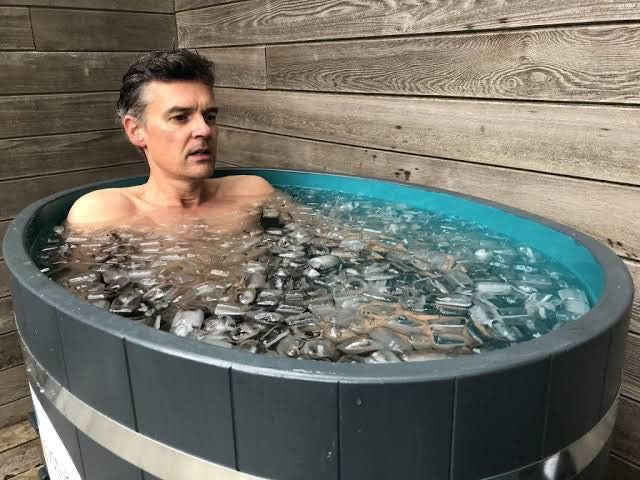Ever wondered how long to brave an Ice Bath without turning into a popsicle? Short answer: 1–5 minutes per Cold Plunge (Huberman-style). Want to master your Cold Plunge Tub timing, boost mood, and recover like a pro? Keep reading for all the chilly details!

2. Understanding Dr. Huberman's Core Cold Plunge Recommendations
2.1 Optimal Duration and Frequency
2.1.1 The "11 Minutes Per Week" Rule (Total Weekly Exposure)
Dr. Andrew Huberman suggests a total of 11 minutes per week of cold exposure.
This is spread across several short sessions.
It’s linked to better mood, focus, metabolism, and stress resilience.
It’s not about a marathon soak, but about being consistent.
2.1.2 Recommended Session Lengths (1–5 minutes) and Distribution (2–4 sessions/week)
Sessions typically last 1 to 5 minutes.
Aim for 2 to 4 sessions weekly to hit your target.
Regular exposure helps the body adapt without overstress.
It’s all about sustainable practice.
2.1.3 The Relationship Between Temperature and Duration (Colder = Shorter)
Colder water means shorter stays.
Huberman advises adjusting time to match temperature.
Lower temperatures call for brief, safer sessions.
Aim for uncomfortably cold but safe.
2.2 Ideal Temperature Range and Mindset
2.2.1 "Uncomfortably Cold Yet Safe" (e.g., 45°F–60°F / 7°C–15°C)
The sweet spot is 7°C–15°C (45°F–60°F).
It should challenge you but stay safe.
Too warm? Too easy. Too cold? Risky.
Find your balanced discomfort zone.
2.2.2 Cultivating "Top-Down Control" and Resilience ("Counting Walls" Approach)
Use mental strategies to handle discomfort.
Huberman calls this “counting walls”—noticing but not panicking.
It trains mental resilience.
Learn to stay calm under stress.
2.2.3 The Importance of Controlled Breathing During Immersion
Slow breathing reduces shock.
Focus on long exhales to signal safety to your body.
This calms your heart rate.
Inhale through the nose, exhale slowly through the mouth.
3. Maximising Benefits: Huberman's Advanced Cold Exposure Techniques

3.1 Enhancing Physiological Responses
3.1.1 The Søberg Principle: Reheating Naturally for Metabolic Boost (Shivering, No Towel)
After plunging, avoid artificial reheating.
Let your body warm itself naturally.
This activates brown fat and boosts metabolism.
It’s tough, but it trains adaptation.
3.1.2 Activating the Mammalian Diving Reflex (Face Immersion)
Face immersion triggers the mammalian diving reflex.
It slows heart rate and calms you.
Try dipping your face or splashing cold water.
A quick relaxation hack.
3.1.3 Optimising Dopamine and Adrenaline Release for Mood and Focus
Cold plunges cause sustained dopamine and adrenaline spikes.
This lifts mood and sharpens focus for hours.
It’s a natural alertness boost.
No coffee needed.
3.2 Strategic Timing and Integration with Training
3.2.1 Best Time of Day for Cold Plunges (Morning for Alertness)
Morning plunges improve wakefulness and focus.
Perfect for starting the day strong.
Avoid late-night plunges to protect sleep.
Use them to kickstart productivity.
3.2.2 Avoiding Cold Plunges After Hypertrophy Training (Recovery Considerations)
Don’t plunge right after strength sessions.
It can blunt muscle growth.
Separate strength work and cold exposure by hours.
Plan smart for best results.
3.2.3 Cold-Hot Contrast Therapy (Ending with Cold)
Contrast therapy alternates hot and cold.
Always finish on cold for resilience benefits.
It trains your nervous system.
Supports recovery and circulation.
4. Safety First: Important Considerations for Cold Plunging
4.1 General Safety Guidelines
4.1.1 Starting Slowly and Gradually Increasing Exposure
New to plunging? Start with 1 minute.
Increase gradually as tolerance grows.
No need to rush.
Consistency beats heroics.
4.1.2 Listening to Your Body and Avoiding Over-Exposure
It should be tough but safe.
Get out if you feel dizzy, numb, or panicked.
Respect your limits.
Safety first.
4.1.3 When to Consult a Healthcare Professional (Pre-existing Conditions, Medications)
If you have heart conditions or chronic illnesses, check with a doctor first.
Some medications affect cold response.
Better safe than sorry.
Your Cold Plunge Tub will wait!
5. Takeaways
-
Consistency matters: Aim for 11 minutes total per week, split into 2–4 sessions.
-
Keep it uncomfortably cold but safe: 7°C–15°C is the sweet spot.
-
Breathe slowly: Control stress with calm exhalations.
-
Time it right: Morning plunges help alertness; avoid after heavy strength training.
-
Stay safe: Listen to your body and consult a professional if needed.
6. Conclusion
Cold Plunge, Ice Bath Tub, or Cold Plunge Tub—it doesn’t matter what you call it, the benefits can be huge when done properly. By understanding the optimal timing, temperature, and safety guidelines recommended by experts like Dr. Huberman, you can harness cold water therapy for physical recovery, mental clarity, and stress resilience. Take the plunge wisely and reap the rewards!






